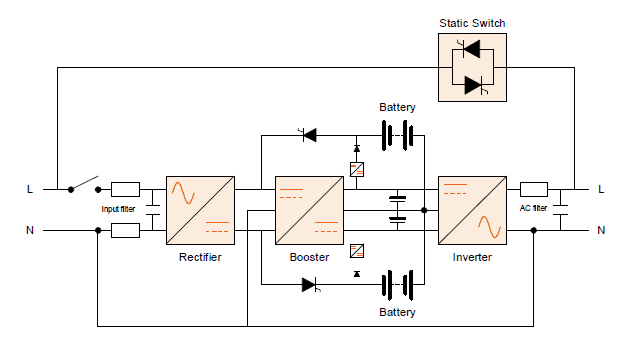Three distinct types of isolation may be used within a UPS system, although how – or even if – they’re implemented depends on the UPS type and the application. In summary, they are:
- The galvanic isolation between input and output
- The input isolation between mains and battery
- The isolation between the dc circuit and the UPS output
What is the function of isolation in a UPS transformer?
Isolation in a UPS transformer provides separation between the input and output, protecting the connected equipment from electrical faults and surges. It ensures consistent power delivery, improves safety by preventing shock hazards, and resolves grounding or voltage compatibility issues.
Galvanic isolation
In transformer-based UPS systems, the transformer is used to step up the voltage at the output of the inverter to a level compatible with the utility or generator supply voltage. This is known as UPS voltage regulation.
A common misconception is that the transformer is also used to provide galvanic isolation, but this is not the case. If total galvanic isolation is required between the load, inverter and bypass in either a transformer-based or transformerless UPS, an additional transformer is necessary in the UPS circuit. The transformer must be designed with adequate insulation to prevent the high voltages present at the UPS output from jumping between windings and prevent a net dc output component.
Input isolation between mains and battery
In the early 60s, when only open lead-acid batteries were available, galvanic isolation was required for safety reasons. Since the late 80s, when maintenance-free lead-acid or nickel-cadmium batteries came into use, input galvanic isolation was abandoned; it is very rarely found now.
DC component output isolation – transformer-based UPSs
In transformer-based systems, the transformer not only steps up the inverter output voltage but also isolates DC components and therefore the DC circuit from the output load. In older designs, the output transformer also helped to reduce noise on the output waveform. Fig.1 shows the transformer’s position, which is at the output of the inverter, not the UPS output. This means that it will isolate the load from any DC component generated by an inverter fault. However, if a bypass component fails, the considerable DC component that it could generate will reach the load, as the bypass supply does not pass through the transformer – a shortcoming of some transformer-based designs.

Fig.1: Transformer-based UPS
DC component output isolation – transformerless UPSs
As Fig.2 shows, transformerless UPSs lack output transformers, so the DC component issue must be handled differently. Software as well as hardware regulation and control is used to block any DC component at the UPS output, so that it cannot be fed to the load. Provision must be made for both inverter and static bypass faults.
If an inverter fault such as an IGBT failing to conduct develops, a DC component will be generated. A transformerless UPS system will include a fully-redundant EDCP (electronic dc protection) circuit to ensure that the probability of this component reaching the inverter output is practically zero.

Fig.2: Transformerless UPS
Inverter EDCP circuits in recent UPS designs comprise three parts:
- Firstly, redundant DC-component regulation continuously detects and regulates the DC component within a tolerance of ±10mV. A normal mains supply to which all non-protected equipment is exposed has a DC-component tolerance of ±300mV.
- Secondly, if the DC component exceeds 4V, the EDCP circuit automatically and instantly transfers the load to bypass. The inverter, rectifier and booster are switched off, the battery is disconnected, and alarms are signalled. To ensure the DC component does not appear on the load side, the protection system operates at all times, even if the UPS is on but switched to bypass. The DC-component detection, regulation and control circuits in modern UPSs are redundant, making the systems extremely safe and secure.
- Thirdly, a DC component may appear on the output if one IGBT fuse blows and the other IGBT continues to conduct. Modern inverter bridges are designed so that if one of their two fuses blows the other fuse will also automatically blow, preventing the DC component from flowing to the load. The probability of a DC component passing through a modern transformerless UPS system is no higher than the probability of a transformer going short-circuit and allowing the DC component to pass.
Similar protection is built into the bypass switch. If one of the static bypass SCRs ceases to conduct, the load will be automatically transferred to the inverter within 2 to 5ms in order to avoid a DC component on the load side.




